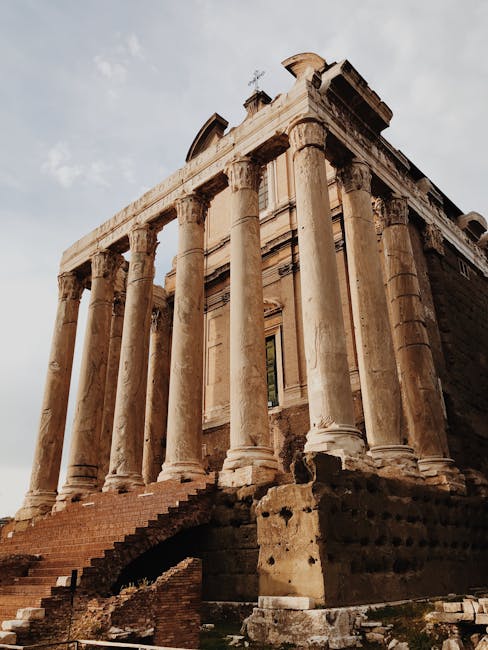Key Takeaways
- The Agora and Forum served as central public spaces in ancient Greek and Roman geopolitical structures respectively, facilitating civic life and governance.
- The Agora primarily functioned as a multifunctional public square in Greek city-states, encompassing political, commercial, and social activities.
- The Forum was the hub of Roman urban life, acting as a center for judicial proceedings, religious ceremonies, and commercial exchanges.
- Architectural design and spatial organization of the Agora and Forum reflect distinct cultural priorities and urban planning philosophies of Greece and Rome.
- Both spaces contributed significantly to the development of democratic and legal systems, yet their roles and symbolism diverged according to their respective societies.
What is Agora?

The Agora was the heart of political and social life in ancient Greek city-states, serving as a public open space where citizens gathered. It was a multifunctional area combining commerce, politics, and social interaction under one expansive geographic boundary.
Political Center and Civic Engagement
The Agora provided a venue for democratic assemblies where citizens debated and voted on policies, embodying the principles of direct democracy. Public speeches and discussions frequently took place here, emphasizing active participation in governance. This space was crucial for fostering a sense of community and shared responsibility among Greek citizens. The open-air environment allowed for large gatherings, facilitating transparency and collective decision-making in city administration.
Commercial Activities and Market Functions
Besides its political functions, the Agora was a bustling marketplace where merchants sold goods ranging from food to artisanal crafts. These commercial exchanges were essential for the economic vitality of the polis, encouraging trade within and beyond city boundaries. Market stalls and shops lined parts of the Agora, creating a dynamic economic ecosystem. The integration of trade with civic life highlights the Agora’s role as a multifaceted public domain.
Social and Cultural Interactions
The Agora was more than a marketplace or political forum; it was a social hub where citizens met, exchanged ideas, and participated in cultural events. Philosophers like Socrates often used the Agora as a platform for teaching and engaging with the public. This intermingling of social, intellectual, and political activities made the Agora a uniquely vibrant space. It also hosted religious festivals and ceremonies, reinforcing its role as a focal point of communal identity.
Architectural Layout and Urban Integration
Architecturally, the Agora was typically an open rectangular space surrounded by stoas—covered walkways providing shelter and space for shops and public gatherings. The design emphasized accessibility and openness, encouraging free movement and interaction among participants. Temples and public buildings often bordered the Agora, integrating religious and administrative functions. This layout reflected the Greek emphasis on balance, proportion, and the seamless blending of civic and sacred spaces.
What is Forum?

The Forum was the central public area in Roman cities, serving as the nucleus of political, judicial, commercial, and religious life. It was an enclosed or semi-enclosed plaza surrounded by important governmental and religious buildings, reflecting the structured nature of Roman urbanism.
Judicial and Administrative Functions
The Roman Forum was the primary site for legal proceedings and public administration, where magistrates conducted trials and official decrees were announced. This centralized function underscored the Roman emphasis on law, order, and bureaucratic governance. Public offices and basilicas located around the Forum supported its role as a hub of civic administration. The Forum thus symbolized the authority and organizational complexity of Roman political life.
Religious and Ceremonial Importance
Temples and shrines within the Forum highlighted its religious significance, hosting rituals and festivals dedicated to Roman deities. These ceremonies reinforced the intertwining of religious observance with public and political affairs. The presence of monumental temples like the Temple of Saturn illustrated the Forum’s role as a sacred as well as civic space. Religious processions often began or ended in the Forum, making it the spiritual heart of the city.
Commercial Exchange and Economic Activity
Similar to the Agora, the Forum was a bustling commercial center where merchants, bankers, and traders conducted business. However, Roman commercial activity was often more regulated and formalized, reflecting the empire’s administrative sophistication. Market stalls, shops, and offices surrounded the Forum, creating a dense economic environment. This commercial vitality supported the city’s function as a hub within broader trade networks across the empire.
Urban Design and Architectural Grandeur
Roman Forums were characterized by grandiose architecture, including monumental arches, basilicas, and colonnaded courtyards that conveyed imperial power. The enclosed nature of the Forum contrasted with the more open Greek Agora, reflecting Roman preferences for order and hierarchy. The spatial arrangement facilitated controlled access and ceremonial processions, emphasizing the Forum’s official status. These urban design elements underscored Rome’s emphasis on grandeur and authority in public spaces.
Comparison Table
The following table compares core attributes of the Agora and Forum, highlighting their distinct roles and characteristics within ancient geopolitical contexts.
| Parameter of Comparison | Agora | Forum |
|---|---|---|
| Geographical Setting | Open-air, often irregularly shaped central square within Greek city-states | Enclosed or semi-enclosed plaza typically at the heart of Roman cities |
| Primary Functions | Political assemblies, marketplace, social gatherings | Judicial courts, religious ceremonies, commercial exchange |
| Architectural Features | Stoas, temples, open spaces for assembly | Basilicas, arches, temples, colonnades |
| Political Role | Venue for direct citizen participation and debate | Center for magistrates’ governance and legal administration |
| Religious Significance | Temples and altars integrated with public life | Monumental temples and ritual spaces emphasizing state religion |
| Economic Activities | Informal markets and merchant stalls | Regulated commercial venues and banking offices |
| Social Interaction | Hub for philosophical discourse and cultural exchange | Focus on official ceremonies and public announcements |
| Urban Symbolism | Embodiment of democratic ideals and communal life | Representation of imperial authority and legal order |
| Access and Layout | Generally open access encouraging inclusive participation | Controlled entry emphasizing formal processions and hierarchy |
Key Differences
- Functionality Scope — The Agora combined political, commercial, and social roles with a strong emphasis on citizen democracy, whereas the Forum prioritized judicial and administrative uses aligned with imperial governance.
- Spatial Design — The Agora’s open and flexible layout contrasted with the Forum’s architecturally enclosed and monumental design, reflecting different cultural values toward public space.
- Religious Integration — While both contained religious elements, the Forum’s temples were grander and more state-focused, highlighting Rome’s intertwining of religion and politics.
- Social Dynamics — The Agora fostered informal philosophical discourse and community debate, whereas the Forum served as a venue for official announcements and formal ceremonies.
- Economic Regulation — Commercial activities in the Agora were more loosely organized, compared to